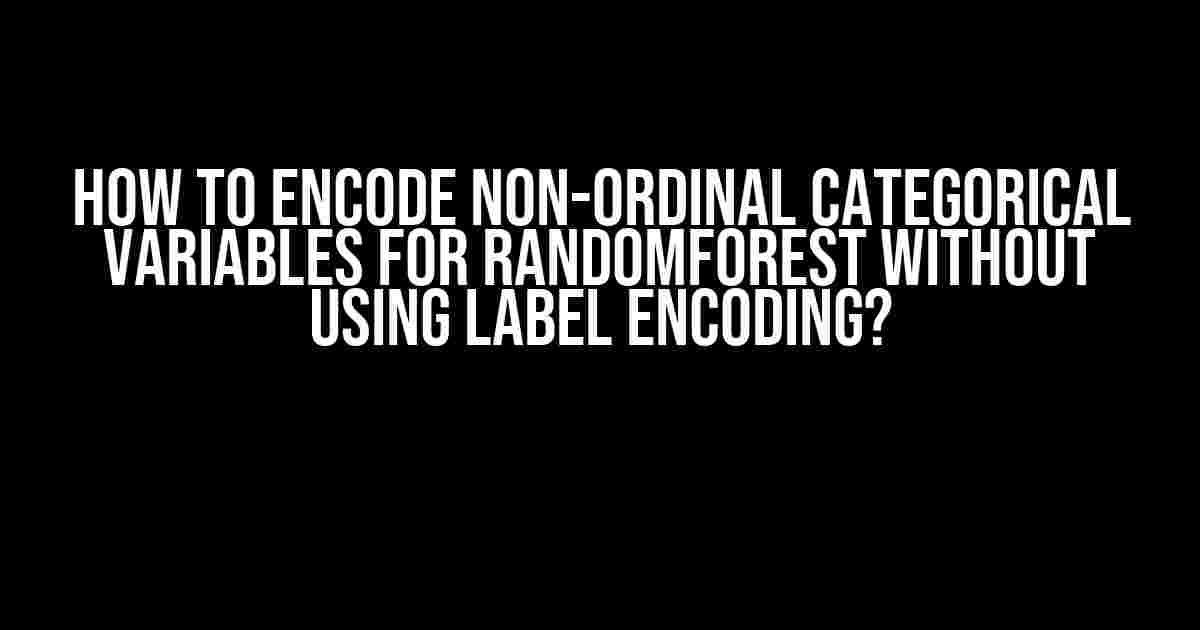Welcome to the world of machine learning, where data preprocessing is an art form! In this article, we’ll dive into the fascinating realm of encoding non-ordinal categorical variables for RandomForest, sans Label Encoding. Yes, you read that right – we’re going to explore alternative methods to make your categorical variables shine in the RandomForest algorithm, without relying on Label Encoding. Buckle up, folks!
What’s the fuss about Label Encoding?
Label Encoding is a common technique used to convert categorical variables into numerical variables that can be fed into machine learning algorithms. But, it has its limitations. When dealing with non-ordinal categorical variables (i.e., categories that don’t have a natural order), Label Encoding can lead to:
- Arbitrary ranking: Label Encoding assigns numerical values to categories based on alphabetical order or some other arbitrary method, which can be misleading.
- Loss of information: The resulting numerical values may not capture the underlying relationships between categories.
- Model bias: The algorithm may learn to rely too heavily on the arbitrary numerical values, leading to poor generalization.
So, what are our alternatives?
Fear not, dear reader! We have several alternatives to Label Encoding that can help us unlock the full potential of our non-ordinal categorical variables in RandomForest. Let’s explore:
1. One-Hot Encoding (OHE)
One-Hot Encoding is a popular technique that creates a binary vector for each category, where all values are 0 except for one that is 1. This approach:
- Preserves information: OHE maintains the original categorical information, without assigning arbitrary rankings.
- Improves interpretability: The resulting binary vectors are easy to understand and visualize.
from sklearn.preprocessing import OneHotEncoder
ohe = OneHotEncoder()
encoded_data = ohe.fit_transform(categorical_data)
print(encoded_data.toarray())
2. Binary Encoding
Binary Encoding is similar to OHE, but it uses a single binary vector for all categories, making it more space-efficient. This method:
- Reduces dimensionality: Binary Encoding requires fewer features than OHE, which can be beneficial for high-cardinality datasets.
- Improves computational efficiency: Faster computation times compared to OHE.
from sklearn.preprocessing import Binarizer
binarizer = Binarizer()
binary_data = binarizer.fit_transform(categorical_data)
print(binary_data)
3. Hashing Trick
The Hashing Trick is a technique that maps categorical variables to numerical indices using a hash function. This approach:
- Fast and efficient: The Hashing Trick is computationally inexpensive and can handle high-cardinality datasets.
- Flexible: Can be used with various machine learning algorithms.
from sklearn.feature_extraction import FeatureHasher
hasher = FeatureHasher(n_features=10)
hashed_data = hasher.fit_transform(categorical_data)
print(hashed_data)
4. Embeddings
Embeddings, a.k.a. categorical embeddings, are a powerful technique that learns dense vector representations for categorical variables. This approach:
- Captures relationships: Embeddings can learn complex relationships between categories.
- Improves model performance: Can lead to better performance in machine learning models.
from category_encoders import CatBoostEncoder
encoder = CatBoostEncoder()
embedded_data = encoder.fit_transform(categorical_data, target_variable)
print(embedded_data)
5. Ordinal Encoding with Domain Knowledge
- Preserves information: Ordinal Encoding with domain knowledge maintains the underlying meaning of the categories.
- Improves interpretability: The resulting ordinal values are easy to understand and visualize.
ordinal_data = pd.Categorical(categorical_data, categories=['low', 'medium', 'high'], ordered=True)
print(ordinal_data)
Comparison of Encoding Methods
Let’s compare the encoding methods we’ve discussed, focusing on their strengths and weaknesses:
| Encoding Method | Strengths | Weaknesses |
|---|---|---|
| OHE | Preserves information, improves interpretability | High dimensionality, computationally expensive |
| Binary Encoding | Reduces dimensionality, improves computational efficiency | Loses information, less interpretable |
| Hashing Trick | Fast and efficient, flexible | Potentially loses information, may require tuning |
| Embeddings | Captures relationships, improves model performance | Requires large datasets, computationally expensive |
| Ordinal Encoding with Domain Knowledge | Preserves information, improves interpretability | Requires domain knowledge, may not be applicable |
Conclusion
There you have it – a comprehensive guide to encoding non-ordinal categorical variables for RandomForest without using Label Encoding. Each method has its strengths and weaknesses, and the choice ultimately depends on the specific problem, dataset, and performance metrics. Remember:
- Understand your data: Before choosing an encoding method, take the time to understand the underlying structure and relationships in your data.
- Experiment and iterate: Try out different encoding methods and evaluate their impact on model performance.
- Don’t be afraid to mix and match: Combine different encoding methods to create a robust and efficient approach.
Now, go forth and conquer the world of machine learning with your newfound knowledge of encoding non-ordinal categorical variables!
Frequently Asked Question
Get ready to crack the code on encoding non-ordinal categorical variables for RandomForest without using Label Encoding!
Q1: What’s the problem with using Label Encoding for categorical variables?
Label Encoding can lead to the assumption of ordinality, which can be misleading for non-ordinal categorical variables. This can result in poor model performance and inaccurate predictions. Yikes!
Q2: What’s an alternative to Label Encoding for encoding categorical variables?
One-hot Encoding (OHE) is a popular alternative to Label Encoding. OHE creates a binary vector for each category, allowing the model to treat each category independently. However, it can lead to the curse of dimensionality for high-cardinality categorical variables.
Q3: How does Random Forest handle categorical variables internally?
Random Forest uses a technique called “tree-based encoding” to handle categorical variables. It creates multiple decision trees, each with a different subset of features. This allows the model to learn complex interactions between categorical variables and other features.
Q4: Can I use Hashing Trick or Binary Vectorizers for encoding categorical variables?
Yes, you can! Hashing Trick and Binary Vectorizers are alternative encoding methods that can be used for categorical variables. Hashing Trick reduces the dimensionality of the encoded vector, while Binary Vectorizers create a compact binary representation of the categorical variable.
Q5: What’s the key takeaway for encoding non-ordinal categorical variables for RandomForest?
The key takeaway is to avoid Label Encoding and instead use alternative encoding methods such as One-hot Encoding, Hashing Trick, or Binary Vectorizers. This allows the model to learn meaningful relationships between the categorical variables and other features, leading to better performance and more accurate predictions!

